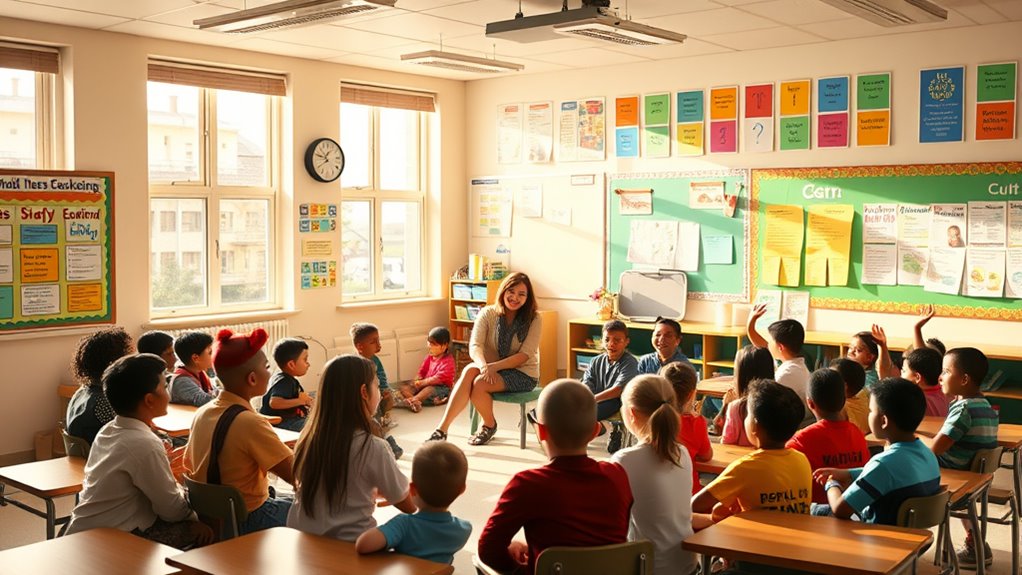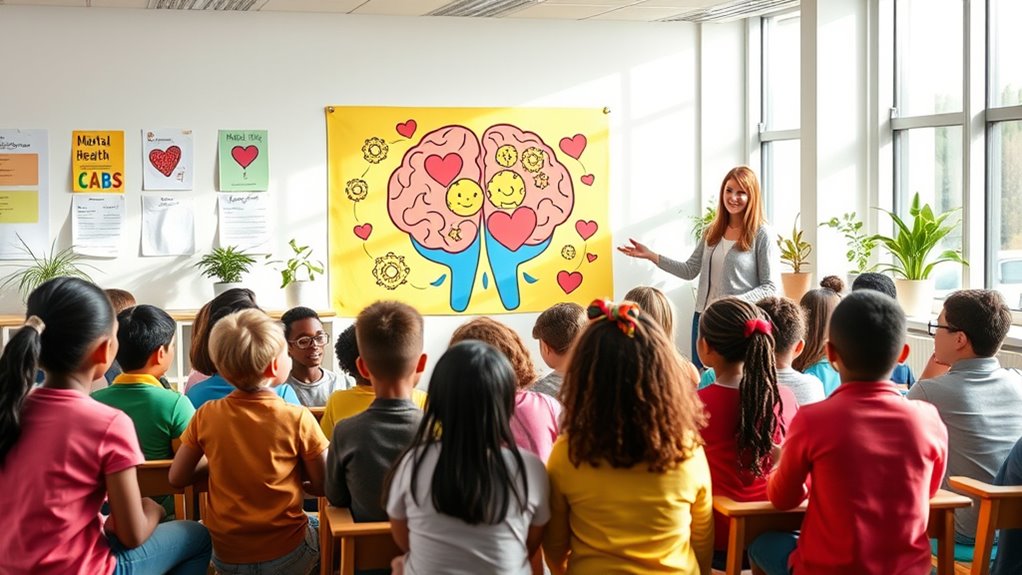Integrating mental health education in schools helps create a safe space where students can openly discuss their struggles and support each other. By normalizing mental health as part of overall well-being, you can reduce stigma and encourage help-seeking behavior. It also fosters peer support, builds empathy, and enhances emotional resilience, leading to a better school environment. Continuing to explore this topic offers valuable insights into how schools can effectively promote mental health.
Key Takeaways
- Incorporate age-appropriate mental health curricula to normalize discussions and reduce stigma among students.
- Train teachers and staff to recognize mental health signs and respond effectively.
- Promote peer-led initiatives and support groups to foster empathy and open dialogue.
- Create a supportive school environment that encourages mental health conversations and reduces shame.
- Collaborate with mental health professionals to provide resources, workshops, and referral pathways.

Mental health education in schools is becoming increasingly essential as more students face mental health challenges today. When you incorporate mental health topics into the curriculum, you help create a safer environment where students feel comfortable discussing their struggles. One of the key benefits of this approach is stigmatization reduction. By openly talking about mental health, misconceptions are challenged, and students learn that mental health issues are common and treatable. This destigmatization encourages students to seek help without fear of judgment or shame. When students see mental health as a normal part of overall well-being, they’re more likely to support each other and reach out when needed.
Peer support plays an indispensable role in this educational shift. When mental health is integrated into school programs, students often form connections that foster understanding and empathy. Peer-led initiatives, support groups, or classroom discussions empower students to share their experiences and listen to others. These interactions build a sense of community, making it easier for students to ask for help and offer support to friends who might be struggling. Through peer support, students realize they’re not alone, which can considerably boost their confidence and resilience. As they develop these supportive relationships, they begin to normalize conversations about mental health, breaking down barriers that often prevent students from seeking assistance. Additionally, the inclusion of mental health education can improve cognitive performance by reducing stress and anxiety, enabling students to focus better on their studies.
Furthermore, integrating mental health education helps teachers and staff recognize early warning signs of distress. When educators are trained to identify issues such as anxiety, depression, or bullying, they can intervene promptly and refer students to appropriate resources. This proactive approach not only benefits individual students but also fosters a school culture where mental health is prioritized. As a result, the entire school environment becomes more inclusive and understanding, promoting better academic performance and emotional well-being.
Frequently Asked Questions
How Can Teachers Effectively Address Mental Health Stigma?
You can effectively address mental health stigma by fostering open conversations and promoting peer support among students. Encourage peer-led initiatives and anti-stigma campaigns that challenge misconceptions and normalize mental health discussions. Be proactive in creating a safe, inclusive environment where students feel comfortable sharing their experiences. Your active engagement helps break down barriers, making mental health a natural part of classroom dialogue and reducing stigma over time.
What Training Do Teachers Need for Mental Health Education?
Think of yourself as a gardener nurturing growth; you need the right tools. Teachers should receive training in classroom strategies that foster emotional safety and curriculum development that includes mental health topics. This training helps you recognize signs of distress, handle conversations with empathy, and create an inclusive environment. By equipping yourself with this knowledge, you’re planting seeds of understanding that will blossom into healthier, more resilient students.
How Is Student Privacy Protected During Mental Health Discussions?
You protect student privacy during mental health discussions by following strict confidentiality policies and privacy safeguards. You guarantee that sensitive information remains confidential, sharing it only with authorized personnel or with student consent. You also create a safe environment where students feel comfortable opening up, knowing their privacy is respected. Regular training helps you stay updated on best practices, reinforcing your commitment to maintaining trust and confidentiality in all mental health conversations.
What Role Do Parents Play in Mental Health Education?
Parents play a essential role in mental health education by fostering open communication and supporting their child’s understanding. While schools provide structured lessons, your involvement through active listening and honest conversations reinforces learning. Using effective communication strategies, like empathy and patience, helps your child feel safe discussing their feelings. This partnership creates a balanced approach, ensuring your child’s mental well-being is prioritized both at home and in school.
How Is the Effectiveness of Mental Health Programs Measured?
You measure the effectiveness of mental health programs through program evaluation and outcome measurement, which involve collecting data on students’ mental health improvements, knowledge gains, and behavior changes. You can use surveys, interviews, and assessments before and after the program to track progress. By analyzing this data, you determine whether the program meets its goals and identify areas for improvement, ensuring your efforts positively impact students’ mental well-being.
Conclusion
By integrating mental health education into your school, you’re not just teaching students – you’re transforming lives, saving futures, and building superheroes of resilience. Imagine a world where every student feels understood, supported, and unstoppable. This isn’t just an idea; it’s a revolution waiting to happen. So, take action now, because the future of mental wellness depends on the choices you make today. Together, you can create a tsunami of change that echoes for generations!









